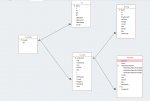Ok a description of the business:
I am the crocodile response coordinator for FWC (state wildlife agency) When the public sees what they deem as a nuisance crocodile they call the SNAP (Statewide Nuisance Alligator Program) hotline. After that a SNAP# is created and location information and information about the "complainant" taken. Then if needed a Crocodile Response Agent (CRA) is sent to the scene to investigate and sometimes relocate the animal. During relocation measurements are taken and, if not previously handled by FWC, tagged and clipped for future identification.
As far as measurements not changing over time, if the crocodile is an adult the growth rate is much slower. If an animal is measured twice, one month apart, there will be little to no change in the measurements. Two weeks apart there would not be any change at all. Two years apart and you will definitely see a change.
Alive or not I thought it made sense to associate that with the crocodile itself. I guess it would make more sense to associate that with a location though. there I go again thinking like a biologist and not a data manager.
The note or sighting is recorded in a different system completely separate from this database (SNAP) and is referenced by the SNAP#
[edit] The notes are copied into Access and handling reports are submitted by CRAs after handling a croc

